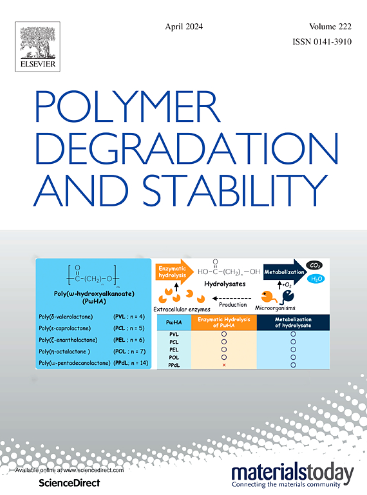结晶反式-1,4聚丁二烯-共异戊二烯嵌段共聚物(tir)改性天然橡胶阻燃复合材料的研究
IF 6.3
2区 化学
Q1 POLYMER SCIENCE
引用次数: 0
摘要
研究了反式-1,4-聚丁二烯-共异戊二烯嵌段共聚物橡胶(tir)与天然橡胶(NR)和膨胀型阻燃剂(IFR)简单机械共混的阻燃性能。与NR@IFR复合材料相比,NR/TBIR@IFR复合材料的力学性能得到了显著提高。特别是随着tir添加量的增加,100%拉伸疲劳寿命提高了129.3%,解决了添加阻燃剂导致力学性能下降的问题。NR/TBIR@IFR极限氧指数(LOI)值略有提高,通过UL-94垂直燃烧试验,离火后达到自熄要求。加入tir后,NR/TBIR@IFR系统的峰值放热率(PHRR)由295 kW/m2降至228.8 kW/m2,总放热率(THR)由118.11 MJ/m2降至99.32 MJ/m2。采用扫描电镜(SEM)、能谱仪(EDS)和拉曼光谱分析了添加tir后材料的阻燃机理。研究结果表明,tir通过与均匀分散的阻燃剂协同构建网状结构,促进了连续致密碳层的快速形成,有效抑制了NR复合材料在凝聚相和气相中的燃烧行为。tir的加入不仅改善了阻燃剂在橡胶基体中的分散性,而且通过界面协同效应提高了NR复合材料的阻燃性能和力学性能。为高疲劳使用环境下阻燃橡胶材料的制备提供了一种新的环保策略。本文章由计算机程序翻译,如有差异,请以英文原文为准。
Investigation into the flame retardant composite of natural rubber modified by crystalline trans-1,4-poly(butadiene-co-isoprene) block copolymer (TBIR)
The flame retardancy of simple mechanical blending of trans-1,4-poly (butadiene-co-isoprene) block copolymer rubber (TBIR) with natural rubber (NR) and intumescent flame retardant (IFR) was investigated in this work. Compared with NR@IFR composite materials, the mechanical properties of NR/TBIR@IFR composite materials had been significantly improved. Especially, as the addition amount of TBIR increased, the 100 % tensile fatigue life was enhanced by 129.3 %, resolving the issue of mechanical property deterioration caused by additive flame retardants. The limit oxygen index (LOI) value of NR/TBIR@IFR was slightly improved and passed the UL-94 Vertical Burning test, fulfilling the requirement of self-extinguishing when removed from the fire. After the addition of TBIR, the peak heat release rate (PHRR) of the NR/TBIR@IFR system decreased from 295 kW/m2 to 228.8 kW/m2, and the total heat release rate (THR) dropped from 118.11 MJ/m2 to 99.32 MJ/m2. The flame retardant mechanism of the material after adding TBIR was analyzed by scanning electron microscopy (SEM), energy dispersive spectrometer (EDS), and Raman spectroscopy. The research results showed that TBIR, by synergistically constructing a network structure with uniformly dispersed flame retardants, promoted the rapid formation of a continuous and dense carbon layer, effectively suppressing the combustion behavior of NR composites in both condensed and gas phases. The addition of TBIR not only improved the dispersion of flame retardants in the rubber matrix but also enhanced the flame retardant and mechanical properties of NR composite materials through interfacial synergistic effects. It provided a new environmentally friendly strategy for the preparation of flame retardant rubber materials for high-fatigue service environments.
求助全文
通过发布文献求助,成功后即可免费获取论文全文。
去求助
来源期刊

Polymer Degradation and Stability
化学-高分子科学
CiteScore
10.10
自引率
10.20%
发文量
325
审稿时长
23 days
期刊介绍:
Polymer Degradation and Stability deals with the degradation reactions and their control which are a major preoccupation of practitioners of the many and diverse aspects of modern polymer technology.
Deteriorative reactions occur during processing, when polymers are subjected to heat, oxygen and mechanical stress, and during the useful life of the materials when oxygen and sunlight are the most important degradative agencies. In more specialised applications, degradation may be induced by high energy radiation, ozone, atmospheric pollutants, mechanical stress, biological action, hydrolysis and many other influences. The mechanisms of these reactions and stabilisation processes must be understood if the technology and application of polymers are to continue to advance. The reporting of investigations of this kind is therefore a major function of this journal.
However there are also new developments in polymer technology in which degradation processes find positive applications. For example, photodegradable plastics are now available, the recycling of polymeric products will become increasingly important, degradation and combustion studies are involved in the definition of the fire hazards which are associated with polymeric materials and the microelectronics industry is vitally dependent upon polymer degradation in the manufacture of its circuitry. Polymer properties may also be improved by processes like curing and grafting, the chemistry of which can be closely related to that which causes physical deterioration in other circumstances.
 求助内容:
求助内容: 应助结果提醒方式:
应助结果提醒方式:


